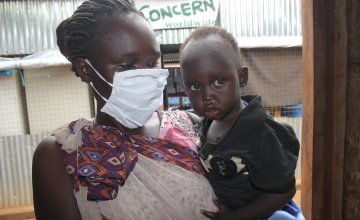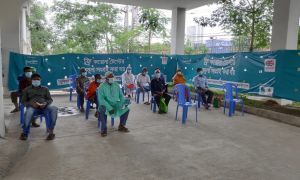
Read our 2024 annual report

Knowledge Hub
Adaptations in the management of child wasting in the context of COVID-19 in South Sudan
This case study outlines the adaptations to COVID-19 that Concern made to our integrated nutrition programme that treats children with severe and moderate acute malnutrition in South Sudan. The adaptations aimed to minimise the risk of COVID-19 transmission while continuing services for the management of child wasting.

The case study demonstrates how the Concern South Sudan team adapted its nutrition programme to continue critical nutrition services during the COVID-19 pandemic. The adaptations ensured a greater continuity of lifesaving Community-based Management of Acute Malnutrition (CMAM) services among the most vulnerable populations while protecting beneficiaries and service providers from contracting COVID-19. The programme adjustments are based on guidance from the South Sudan Nutrition Cluster's COVID-19 guidance.
In addition to acting as a COVID-19 prevention measure, the Family MUAC (mid-upper arm circumference measurement) approach has proven to contribute to increased acceptance, engagement and a sense of ownership of the CMAM programme as caregivers are better able to understand how their children are assessed for admission into the programme and are involved in the monitoring themselves.
The case study can also be viewed on the State of Acute Malnutrition website.
Lessons learned
Successes
- In addition to the guidance from the Nutrition Cluster, Concern Worldwide had detailed guidance outlining how to implement these adaptations, including site set-up, family MUAC training which facilitated easier rollout of the modifications.
- Staff are routinely recruited internally from within the Protection of Civilian (PoC) sites or from the community. Therefore, when access was restricted, staff recruited from the sites were able to continue service provision to enrolled beneficiaries.
- Staff’s workload at the site level decreased as a result of the fewer anthropometric measurements to be taken, simplified dosage, and reduced frequency of follow-up visits. Therefore, staff were able to spend more time in the community rolling out the Family MUAC approach, following up on absentees and defaulters, and conducting risk communication and community engagement (RCCE) activities.
- The Family MUAC approach has contributed to increased acceptance of the CMAM program as caregivers better understand how their children are assessed for admission into the program.
- Engaging lead mothers from mother-to-mother support groups and community nutrition volunteers to supervise Family MUAC implementation at the community level could expand coverage.
Challenges and limitations
- Given the suspensions of community screenings and use of weight-for-height Z-score (WHZ) as an admission criterion, staff are concerned that some eligible children may not be captured and receiving treatment under the current protocol. The resumption of house-to-house community-based screening in July resulted in a dramatic increase in admissions, showing continued need for nutrition services.
- Some caregivers of children enrolled in outpatient therapeutic programme (OTP) who used to receive more than two sachets per day were concerned that the reduced ready-to-use therapeutic food (RUTF) ration their children received under the new protocol would not be enough and expressed frustration at the smaller ration. Staff have addressed this by explaining that this reduction results from a temporary nationwide change in protocol.
- COVID-19 infection prevention and control (IPC) measures have also made monitoring consumption challenging: typically, caregivers are asked to bring the empty sachets back to the site to be counted. In order to avoid touching the used sachets, this practice has been temporarily stopped. Therefore, under current circumstances it is more difficult to monitor how the nutrition supplies are being used.
- Limited supply of MUAC tapes inhibits scale-up of the Family MUAC approach. Conversations are underway to procure additional tapes.
- The Family MUAC approach has thus far been targeted at children under five, who are able to be measured using color-coded MUAC tapes. However, no color-coded tapes exist yet for adults; therefore the approach has not yet been used to screen adults, since many community members are illiterate.
This case study is made possible by the generous support of the American people through the United States Agency for International Development (USAID). The contents are the responsibility of Concern Worldwide and do not necessarily reflect the views of USAID or the United States Government.




